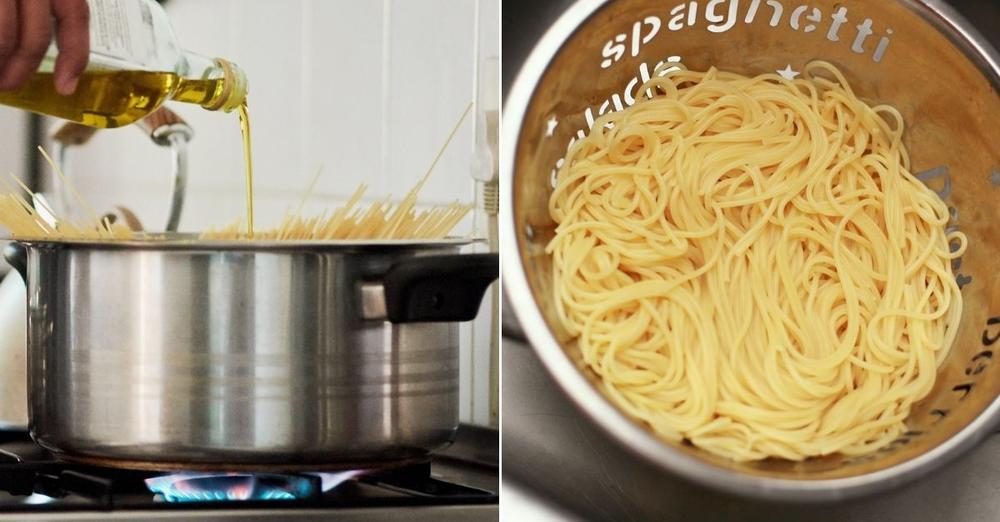10 mistakes you should never make when cooking pasta
More than an ingredient, a real concept of the cuisine; it is the pasta, the Italian pride par excellence. Long, short, mixed, baked or sautéed; a good plate of pasta is never refused as long as it is cooked in the right way. Does this seem like child's play? You may have never thought about these 10 mistakes.
;Resize,width=742;)
Bucatini, spaghetti, penne and rigatoni; Italy is the country of pasta, in all shapes and ways. Water, salt, the right time and the right seasoning are just some of the basic requirements to bring a perfect pasta dish to the table, just like grandma would cook it. But in the kitchen, "simple" preparations can often hide pitfalls and make you fall into error; if your pasta is not cooked to the right point, has split, does not bind or is too tasty, perhaps you have made one of these 10 mistakes .
1. Have clear ideas

Unless you are thinking of a sad pasta without any seasoning, you will have to calculate well the dish you want to taste; so think carefully about the sauce, the proportions and how hungry you are. A portion worthy of the name oscillates between 80 and 100 grams of pasta, for the sauce do not be shy, at most you can dip some good bread in it.
2. The right format is not optional
Have you ever eaten a good amatriciana with tubetti? A nice pasta alla norma with bucatini? No, right? There is a reason and it's simple; long pasta goes well with less dense sauces, short pasta loves ragù meat sauce and seasoning based on vegetables and legumes. Smooth pasta? Better with fish, while stuffed pasta prefers delicate sauces.
3. Not all pastas are the same

There are many types of pasta, different in size, drawing, processing, flour grinding and, of course, cost. A poor quality, we are sorry to say, will make you bring to the table a dish that is not excellent; so, if you are thinking of a special lunch or dinner, just choose a pasta with stoneground flour and maybe bronze drawn, you will not regret it.
4. The salt
The biggest dilemma of cooking pasta; salt, how much and when? Let's start with the quantities; you don't go "as much as is needed", the correct dose is 7-8 grams of coarse salt for every 100 grams of pasta. There are different schools of thought about time; pouring salt directly into cold water slightly increases the time it takes for it to boil, adding it when the water starts to simmer slightly decreases the times, both choices are valid. Anyway be careful never to pour the salt and the pasta into boiling water at the same time; both in fact contribute to lowering the temperature of the water and therefore to interrupt the boiling process. First the salt and then the pasta, please.
5. The oil!?

For some time it has been rumored that adding a few drops of oil to the water helps the pasta not to stick; we believe it is a misdirection conceived by those who claim that ketchup can be a good substitute for tomato sauce. If it were not clear, adding oil is not only a mistake but, in fact, it is absolutely useless; use it for the sauce, water is enough for the pasta.
6. Pots and lids
If you have been careful to choose the right pasta, it goes without saying that even the pot cannot be left to chance. If you are preparing a plate of spaghetti, bucatini or long pasta in general, the pot must be large and with high sides, while for short pasta, even a smaller pot will work, but still large enough to hold all the pasta you want to cook. The lid should only be used before having put the pasta in boiling water, never after. Putting a lid on the pot is used to allow the water to reach the boiling point first while, if placed when the pasta is cooking, it favors the terrible volcano effect, so don’t do it.
7. How much water?

Even in this case, imagination and approximation are not helpful; the proportions are clear and they tell us that for 100 grams of pasta you need one liter of water, to be poured strictly cold. If you use less water, the pasta will most likely stick and cook unevenly, an unforgivable mistake.
8. Cooking times
If there is a number written on the package, there will be a reason; follow the instructions without using your imagination and respect the suggested cooking times. If you are a lover of pasta "al dente" or if your preparation involves a second baking in the oven after the cooking in the water, reduce the cooking times by 2 or 3 minutes.
9. Drain in style

That moment in which time stops in the kitchen; the pasta is cooked, it must be drained immediately. Take a colander suitable to contain all the pasta you will need to drain, place a container under it to keep all or part of the cooking water and pour the pasta gently into the colander. With a ladle of the cooking water you can better sautee the pasta in the sauce, thanks to the starch that will help you to bind the ingredients in the pot together.
10. Never rinse
You have done everything right, your pasta is practically ready so do not miss the last step, do not pass the pasta under cold running water for any reason in the world. Interrupting the cooking process is not a great idea and it risks breaking your beloved rigatoni; the obligatory step is from the colander to the saucepan with the sauce and off for creaming.
;Resize,width=767;)
;Resize,width=712;)


